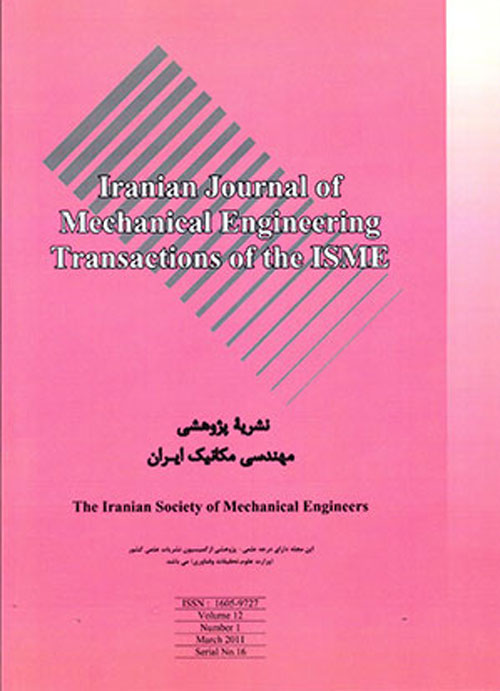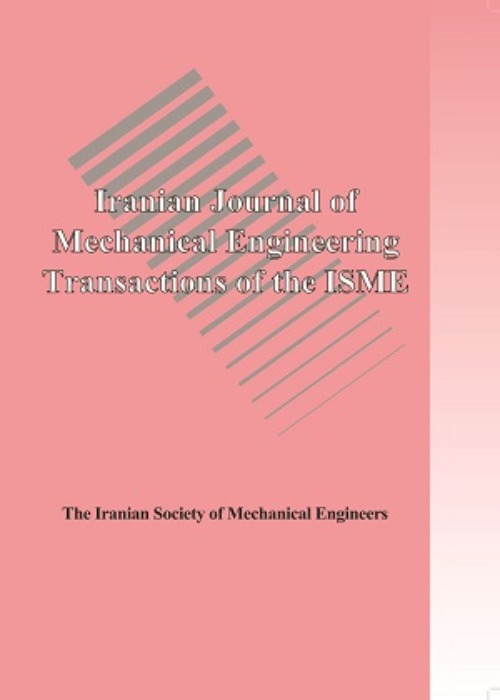فهرست مطالب

Iranian Journal of Mechanical Engineering Transactions of ISME
Volume:16 Issue: 1, Mar 2015
- تاریخ انتشار: 1395/08/15
- تعداد عناوین: 6
-
-
Instruction for the Preparation of Camera-Ready PapersPages 1-4
-
Pages 5-28The aim of the paper is to analyze electro-thermo nonlinear vibration of a double-piezoelectric composite microplate-system (DPCMPS) based on nonlocal piezoelasticity theory. The two microplates are assumed to be connected by an enclosing elastic medium which is simulated by Pasternak foundation. Both of smart composite microplates are made of poly-vinylidene fluoride (PVDF) reinforced by zigzag double walled boron nitride nanotubes (DWBNNTs). The micro-electromechanical model is employed to calculate mechanical, thermal and electrical properties of composite. Using nonlinear strain-displacement relations and considering charge equation for coupling between electrical and mechanical fields, the motion equations are derived based on energy method and Hamilton's principle. These equations cant be solved analytically due to their nonlinear terms. Hence, differential quadrature method (DQM) is employed to solve the governing differential equations for the case when all four ends are clamped supported and free electrical boundary condition. The frequency ratio of DPCMPS is investigated for three typical vibrational states, namely, out-of-phase, in-phase and the case when one microplate is fixed in the DPCMPS. A detailed parametric study is conducted to scrutinize the influences of the small scale coefficient, stiffness of the internal elastic medium, the volume fraction and orientation angle of the DWBNNTs reinforcement, temperature change and aspect ratio. The results indicate that with increasing geometrical aspect ratio, the effect of coupling elastic medium between two smart nanocomposite microplates reduces. This study might be useful for the design and smart control of nano/micro devices such as MEMS and NEMS.Keywords: Nonlinear vibration, Coupled system, Nonlocal piezoelasticity, DWBNNTs
-
Pages 29-51The use of photovoltaic (PV) cells in domestic and industrial applications has grown rapidly through the recent years. Constructing PV plants is a very smart measure to produce free electricity in large scales, especially in the countries with higher solar irradiation potential. On the other hand, compressed air energy storage (CAES) has already been proposed to be employed for energy storage applications. In this work, erecting a large scale grid connected PV plant accompanying with a CAES system to produce either all (if applicable) or a portion of the required electricity, in the most appropriate geographical location in Brazil, is proposed. In the first step, the best point for erecting the power plant is chosen regarding climate and solar engineering considerations. Then, the best tracking mode for the PV cells is opted based on energy and economic considerations. The CAES system is designed and analyzed in the next step. In order to prove the proficiency of the proposal, the performance of the PV plant as well as the CAES unit is assessed for a whole year in the chosen city.Keywords: PV Plant, Tracker, CAES, Energy Analysis
-
Pages 52-72Thispaperpresentsaclearmonographontheoptimizationofthermal instability resistance of the FG (functionally graded) flat structures. For this aim, two FG flat structures, namely an FG beam and an FG circular plate, are considered. These structures are assumed to obey the first-order shear deformation theory, three-parameters power-law distribution of the constituents, and clamped boundary conditions. Theobjectivesoftheoptimizationproblemareconsideredtobemaximizingthecriticalbucklingtemperatureandminimizingthestructural mass. Also, the problems are confined to the range of elastic stability by considering an appropriate constraint criterion. This paper proposes the IMHSA algorithm (improved multi-objective harmony search algorithm) to deal with the stated problem. The capability of the proposed algorithm is examined by solving a benchmark problem. Results are shown as optimal pareto-points for the problems introduced in the paper and some pareto-points are tabulated in detail. Results reveal that the un-symmetric material distribution is not suitable to postpone the buckling temperature of the flat structures.Keywords: Functionallygradedmaterial, Multi, objectiveoptimization, Improvedharmonysearch algorithm, Critical buckling temperature
-
Pages 73-96Impact responses of rectangular composite plates with embedded shape memory alloy (SMA) wires are investigated in the present research. The plate is assumed to be placed in a thermal environment; so that in contrast to the available researches in the field, the shape memory and ferroelasticity effects have to be considered also in addition to the superelasticity. The governing equations are derived based on a proposed enhanced free energy function and refined constitutive equations with coupled thermoelasticity expressions and solved by the finite element method. The resulting governing equations are solved through an iterative solution scheme, a bridging law, and a special phase transformation tracing algorithm. A special case of the results is verified by the experimental results extracted by the authors. Results showed that the volume change rate, impact-induced temperature rise, and ambient temperature may significantly affect the phase transformations mechanism and the non-linear indentation phenomenon.Keywords: Coupled thermoelasticity impact analysis, Shape memory alloy, Pseudoelasticity, Ferroelasticity, Experimental results
-
Pages 97-113In this paper, the solution of a moving Volterra-type screw dislocation in an orthotropic layer, bonded between two piezoelectric layers is obtained using complex Fourier transform. The dislocation solution is then employed as strain nuclei to derive singular integral equations for a medium weakened by multiple moving cracks. These equations, which are classified as, Cauchy singular equations, are then solved numerically for the dislocation densities functions on the crack surfaces. The dislocation densities are employed to determine stress intensity factors for multiple moving cracks. Finally, the effects of the material properties, geometrical parameters and the speed of the crack propagating on the stress intensity factors and strain energy density factor are investigated. It is shown from theses results that the effect of the crack propagation speed can be highly significant.Keywords: Moving screw dislocation, Multiple cracks, Singular integral equations, Stress intensity factors, Strain energy density factor


